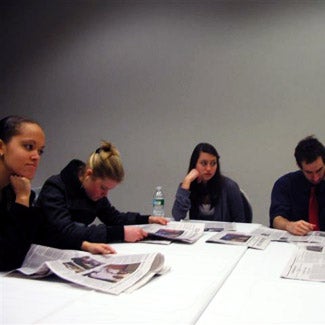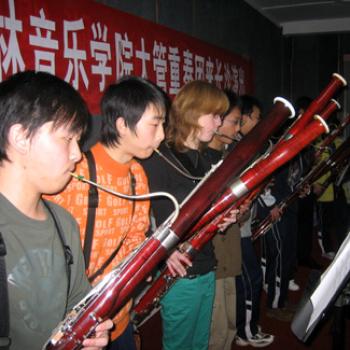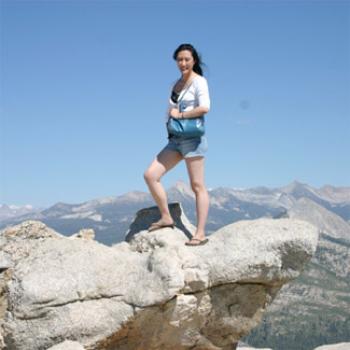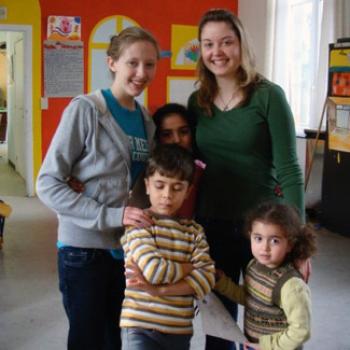On the Oberlin Journalism Workshop
Alicia Smith ’10
“Meeting and working with some of the best in American journalism, many of them Oberlin alumni, was truly inspiring.”

This past Winter Term, I participated in the Oberlin Journalism Workshop in Washington D.C. During the trip, I learned a lot about the life of a journalist, and it heightened my excitement for what my future could hold. Meeting and working with some of the best in American journalism, many of them Oberlin alumni, was truly inspiring.
The biggest lesson I took from the experience was realizing the importance of creating a good, workable story idea. For the workshop, we were required to report and write a story. While in D.C. I pursued a huge and rather abstract story &mdash a phenomenal struggle under a time crunch.
At first, I considered comparing aspects of D.C. culture to other major cities, but most of them were too fluffy for the assignment. After much thought and discussion with our advisor Ferdinand Protzman, I decided to compare the reasons that students at colleges in D.C. chose to attend their schools to the rationale behind Oberlin students’ choice to come to ours.
Reflecting on my own reasons for choosing Oberlin, I recalled the importance of Oberlin’s history as the first college to accept students regardless of race, and decided to focus on whether or not students considered a school’s history in their college search.
I envisioned spending an hour or two at a handful of D.C. colleges interviewing students around their respective campuses. Little did I know that this reporting scheme would be impossible.
Our busy adventure in the city began on Tuesday, January 19th, when we met columnist Bob McCartney at the Washington Post headquarters. McCartney discussed his transition from being an editor to a columnist, and what he views as the main characteristics of good journalism. From there, we were quickly shuffled to a meeting of the section editors, a tour of the newsroom, and a meeting with Marcus Brauchli, the executive editor of the Post.
Listening to the wise words of leading journalists was amazing, but I was getting nervous about my story. My interview-driven article would require many consecutive hours of traveling and talking to students. However, our 48-hour schedule was jam-packed.
After another meeting, we reunited with McCartney for a story conference. He edited each of our stories ahead of time and gave suggestions as to how they could be improved. McCartney let me down eloquently, informing me that my story lacked purpose, needed more research, and was not a concrete idea. While the experience was great, my story was doomed.
We were given about two hours of free time but unfortunately, 120 minutes was not enough to take public transportation to Georgetown and get back in time. This was especially difficult for me since I seemingly lack any sense of direction. Panicked, I decided to find a coffee shop and try to write the skeleton of my story, so I could insert some quotes later. After 30 minutes of caffeinated joints filled to capacity and internet-less establishments, I finally found a Starbucks with a spare corner table and affordable internet. When I sat down to write my story, I quickly realized I could write only so much without material from students.
Thank God for social media.
After a few texts to my Georgetown contacts, I started my first ever Facebook chat interview. Copying and pasting online conversations was not my preferred method of reporting, but with time ticking away, it was my only option.
From there, we met with Oberlin alum Ben Shaw of National Geographic. I tried to stay engaged, but the stress of my story lingered in the back of my mind. What was the point of my story? Some students choose a school based on its history, some don’t. It is an interesting conversation topic, but what makes it worthy of publishing? Why wasn’t I more interested in concrete topics like environmentally friendly modes of transportation or politics?
Many of my friends said that the history of our school sparked their interest. However, as elsewhere in American society, there are uncomfortable encounters as some students carry assumptions and stereotypes into their new experiences on a diverse campus. This can be disappointing to those who hope that the college’s progressive history on racial and gender equality is understood by everyone arriving on campus. Yet Oberlin is still better than most other places with respect to these issues. I went to my laptop again, writing and re-writing about how a school’s history can bring students in but is not always reflected in the present. I was again struck with the burning question: “so what?” A few of my classmates had already completed their articles, and I was still struggling with drafts.
Ready to give up, a meeting with Ferd was in order. We decided that there was no answer to the elusive “so what?” question. Attempting to connect my conversations with Georgetown students to my conversations with Oberlin students would be a stretch beyond stretches. It was time to abandon ship.
Ultimately, my article’s failure was a good thing. Had I written a beautifully crafted piece on a pertinent idea, I wouldn’t have encountered the struggle of pursuing a poorly thought-out story idea. I may have never discovered the difficulty of doing a Facebook interview, and the importance of an on-the-ground, face-to-face interview may have never emerged.
In my book, it’s better to get this failure out of the way now than in ten years when I’m writing for Time magazine. By then, time won’t be on my side. And in real-world journalism, they don’t give extensions.
Tags:
You may also like

On organizing a Bassoon Quartet tour of China
“As someone who was reluctant to go to college “in the middle of a bunch of cornfields,” I now can’t imagine having gone anywhere else for school ... no other institution would be so supportive of my...
Joycelyn Eby ’09

On interning at a hedge fund
“I had preconceived ideas of finance as a lofty, entirely mathematical, robotically exact, and overall boring kind of field. In no way, shape, or form would I have predicted that I would end up where...
Juliette Lu ’12

On her Winter Term in a Belgian refugee center
“As cultural and linguistic barriers melted away, each one of us was able to make valuable friendships with the staff and residents of this center that had opened its arms to us and welcomed any new...
Katie Hart ’11